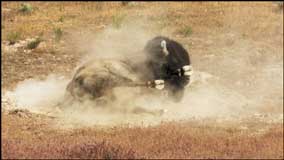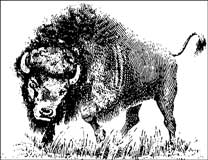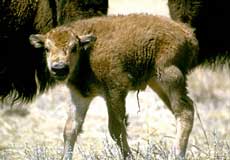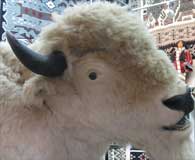Animal Facts
Bison continued
Habits
 Bison like to roll or wallow in soil – either wet or dry. They make a shallow depression, or crater in the earth, roll around and cover themselves with dust or mud.
Bison like to roll or wallow in soil – either wet or dry. They make a shallow depression, or crater in the earth, roll around and cover themselves with dust or mud.
Male and female bison use their short, curved horns to defend themselves and if needed, to fight with other animals in the herd for status or position. Usually bison graze calmly and will let people come up to them, but they can also charge people or machines without warning.
 Bison can move quickly in spite of their size and weight. They can jump from a standing position and spin around on their front and back hooves. They can run faster than a horse and keep going for many miles at more than 64 kilometres an hour (40 miles an hour). When they are on the run they can easily break out of a corral (fenced-in enclosure).
Bison can move quickly in spite of their size and weight. They can jump from a standing position and spin around on their front and back hooves. They can run faster than a horse and keep going for many miles at more than 64 kilometres an hour (40 miles an hour). When they are on the run they can easily break out of a corral (fenced-in enclosure).
Breeding
 Bison mate in August and September, which is late summer and early autumn in North America.
Bison mate in August and September, which is late summer and early autumn in North America.
Next spring, after about 280 days, a calf is born. Calves weigh 11.4 to 18.2 kilograms (25 to 40 pounds) and have yellowish-red fur which is a lighter colour than their parents’ coats.
Calves are born with no hump or horns. Soon after birth they can stand, drink milk from their mother and keep up with their mother and the herd when it moves.
The colour of a calf’s coat darkens after 3 months and horns develop as it grows. The calf drinks its mother’s milk for a year and bison are fully grown at three years old. They live for about 15 years in the wild and up to 25 years in captivity.
White buffalo (bison)
 Sometimes a white bison calf is born. This is a rare event and many Native Americans believe that a white buffalo (bison) is sacred and a sign of good fortune.
Sometimes a white bison calf is born. This is a rare event and many Native Americans believe that a white buffalo (bison) is sacred and a sign of good fortune.


